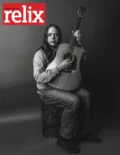
Over the past few years most Jambands.com readers have seen Jeff Coffin in a group setting. The longtime member of Bela Fleck and The Flecktones, has recently devoted himself to the Dave Matthews Band, while also slipping in some shows with his own collective, the Mu’tet (as well as guest appearances with Umphrey’s McGee and others along the way). His latest album however, is something altogether different. It features the saxophone player along with drummer Jeff Sipe. The pair recorded over three days in Brevard, NC, at the Brevard Music Center and the results have just been release on the aptly-titled Duet. In the following conversation he touches on this project, DMB, the Flecktones and what else is on the horizon.
How did you approach this new album? You’ve said that this was sort of a musical conversation that flowed like a stream of consciousness. What was the focus going into this album?
I think the main focus was just to make music together and to try a bunch of different things and decide after the fact what it was going to become—let the music tell us what it wanted to be rather than us trying to dictate the music what we wanted it to be. So when we went in Jeff [Sipe] brought drums, percussion stuff, bells, gongs and I brought everything I had horn wise—whistles, flutes…We basically played for about two and a half days. It was a mixture of parts of tunes, little ideas, melodic ideas…but the primary focus of it was to be improvisational.
So it was basically like an extended jam? Did you collaborate on the written music or was it composed individually?
A bit of both.
It wasn’t mainly based on any mold? The actual idea was to create a piece of pure improvisation?
The idea was to try to have a nice balance leaning more toward the side of improvisation than composition, but there are compositional ideas in there as well. For example, the tune “Should I Stand” is actually the “Pledge of Allegiance” put to music. It’s rhythmically and sympatically, I guess you would say, the “Pledge of Allegiance.” I wanted to have something that I can use also as a teaching tool to talk about music literally as a language and equating sound with speech. I wanted to have something that everyone was familiar with so that they could break that open themselves.
You and Jeff Sipe have a long history of playing together and have formed a close musical bond over the years. Can you talk about how that bond shaped the musical conversation you were having while making this album?
I think there’s a lot of trust there. To me there has to be a lot of trust—there has to be a willingness on all sides to allow you to go to certain depths and emote certain things. We’re sharing a lot of information with each other when we’re playing music. I want to trust the people that I’m playing with that they can carry that information. I think when you have a great friendship between people, like Jeff and I have, there’s a lot of trust that goes into that friendship. It’s about communication and dedication to move on with that relationship.
Were you able to anticipate some of the things that Jeff would do musically, considering your history together?
Yeah, I would say so. But the whole idea…the word improvisation has the root of improvisio, which means “unexpectedness drives.” So rather than having those expectations of knowing what comes next…[we were] not even in that space. We were sort of going into it as a blank slate. Rather than try to anticipate, just leave it as a blank slate and let it happen. Just to be able to be surprised by the unexpected.
So did you edit down the jams or do any overdubs? What was the final result like?
We took everything that we played in the two and a half days and I broke it down into 46 minutes of music. So it’s basically one seamless piece of music. It’s meant to be listened to as one piece, but you can break it up into sections also. We did one percussion overdub that day, but basically everything I took from was from different sections and I just tried to splice it all together—to make it as seamless as possible. In order to do that I had to go through and sort of weed out the stuff I know we weren’t going to use.
And then there’s a whole bunch of possibilities of what we were going to use. So I had to make those decisions based on what I felt was best musically for what was going on. That was sort of the process of getting it done. Then we put in what we call “index points” so you can go to different sections but you can still listen to it as a seamless piece of music.



No Comments comments associated with this post